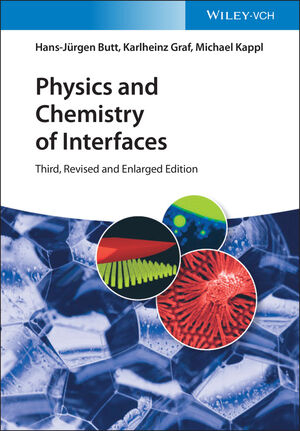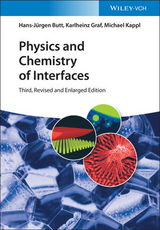Physics and Chemistry of Interfaces
Wiley-VCH (Verlag)
9783527412167 (ISBN)
- Titel ist leider vergriffen;
keine Neuauflage - Artikel merken
The third edition of this excellent textbook for advanced students in material science, chemistry, physics, biology, engineering, or for researchers needing background knowledge in surface and interface science.
The general yet comprehensive introduction to this field focuses on the essential concepts rather than specific details, on intuitive understanding rather than learning facts.
The text reflects the many facets of this discipline by linking physical fundamentals, especially those taken from thermodynamics, with application-specific topics. Similarly, the theory behind important concepts is backed by clearly explained scientific-engineering aspects, as well as by a wide range of high-end applications from microelectronics and biotechnology. Manifold high-end applications from surface technology, biotechnology, and microelectronics are used to illustrate the basic concepts.
New to this edition are such hot topics as second harmonic generation spectroscopy, surface diffusion mechanisms and measurement of surface diffusion, optical spectroscopy of surfaces, atomic layer deposition, superlubricity, bioadhesion, and spin coating. At the same time, the discussions of liquid surfaces, the Marangoni effect, electric double layer, measurement of surface forces, wetting, adsorption, and experimental techniques have been updated, while the number and variety of exercises are increased, and the references updated.
Hans-Jürgen Butt is Director at the Max Planck Institue for Polymer Research in Mainz, Germany. He studied physics in Hamburg and Göttingen, Germany. Then he went to the Max-Planck-Institute of Biophysics in Frankfurt. After receiving his Ph.D. in 1989 he went as a post-doc to Santa Barbara, California, using the newly developed atomic force microscope. From 1990-95 he spent as a researcher back in Germany at the Max-Planck-Institute for Biophysics. In 1996 he became associate professor for physical chemistry at the University Mainz, three years later full professor at the University of Siegen. Only two years later he joined the Max-Planck-Institute of Polymer Research in Mainz and became director for Experimental Physics.
Karlheinz Graf graduated at the Institute for Physical Chemistry in Mainz, and spent a postdoc year at the University of California, Santa Barbara (UCSB). He has served as Project leader at the Max-Planck-Institute for Polymer Research, where his research concentrates on droplet evaporation, the structuring of polymer surfaces, and on constructing a MPIA which is a special AFM capable of measuring forces between a solid surface and an adaptive lipid monolayer in a Langmuir trough. Afterwards he was acting Professor in the Physical and in the Analytical Chemistry of the University of Siegen and, later on, a staff scientist at the Gutmann group at the University of Duisburg-Essen. Recently he became Professor for Physical Chemistry at the University of Applied Sciences (Hochschule Niederrhein) in Krefeld.
Michael Kappl studied physics at the University of Regensburg and the Technical University of Munich, and did his PhD thesis work in Ernst Bamberg's group at the Max-Planck-Institute of Biophysics in Frankfurt. After a year of postdoctoral research at the University of Mainz in the group of Prof. Butt, he worked as a consultant for Windows NT network solutions at the Pallas Soft AG, Regensburg. In 2000, he rejoined the group of Prof. Butt. Since 2002 he is project leader at the Max-Planck-Institute for Polymer Research. By using focused ion beam methods, his investigates the adhesion and friction of micro- and nanocontacts, and capillary forces.
1. Introduction
2. Liquid Surfaces
3. Thermodynamics of Interfaces
4. Charged Interfaces and the Electric Double Layer
5. Surface Forces
6. Contact Angle Phenomena and Wetting
7. Solid Surfaces
8. Adsorption
9. Surface Modification
10. Friction, Lubrication, and Wear
11. Surfactants, Micelles, Emulsions, and Foams
12. Thin Films on Surfaces of Liquids
13. Solutions to Exercises
14. Analysis of Diffraction Patterns
"The book is highly recommended as a source of key information or inspiration and as an introduction to a fascinating and multi-facetted field of research and technology." (Advanced Materials)
"... the book is well worth a place on the shelf of material scientists and engineers involved in surface phenomena." (Materials World)
"This textbook is really an excellent reference work for advanced students (and their teachers) in material science, chemistry, physics, biology, engineering, or for researchers needing background knowledge in this field. I believe that it should be considered mandatory reading for someone who wants to join this research area. It is very didactic, clear, concise, and well-organized...I really enjoyed reading the book...There are several other books dealing with surface and interface science, but this is probably the best for a general introduction to this subject." (ChemPhysChem)
Comments on the previous editions
"A general yet comprehensive introduction to surface and interface science, this book focuses on essential concepts, and includes application from biotechnology to micoelectronics." (Materials World)
"... an excellent tool that is highly recommendable to students and experts equally." (TU Chemnitz)
| Erscheint lt. Verlag | 19.3.2013 |
|---|---|
| Verlagsort | Weinheim |
| Sprache | englisch |
| Maße | 170 x 240 mm |
| Gewicht | 911 g |
| Einbandart | Paperback |
| Themenwelt | Naturwissenschaften ► Chemie ► Physikalische Chemie |
| Naturwissenschaften ► Physik / Astronomie | |
| Technik ► Maschinenbau | |
| Schlagworte | Dünnschichttechnologie • Grenzfläche • Oberflächenphysik • Oberflächentechnik • Schnittstelle |
| ISBN-13 | 9783527412167 / 9783527412167 |
| Zustand | Neuware |
| Informationen gemäß Produktsicherheitsverordnung (GPSR) | |
| Haben Sie eine Frage zum Produkt? |
aus dem Bereich





